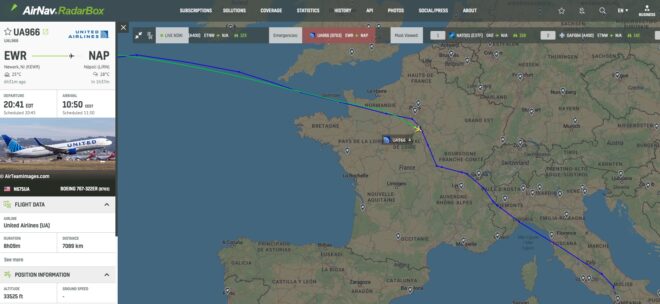
United flight from Newark to Naples is declaring an emergency over France.
United Airlines flight #UA966 is declaring an emergency (squawk 7700) near Paris, France.
The Boeing 767-300ER (registration N675UA) departed Newark at 20:40 EDT yesterday (Thursday) to Naples, Italy.
In a concerning development, United Airlines flight UA966 has declared an emergency while flying over France, just north of Paris. The flight, a Boeing 767-300ER registered as N675UA, was en route from Newark Liberty International Airport in New Jersey to Naples, Italy, when the emergency occurred. Departing from Newark at 20:40 EDT on Thursday, the flight had been expected to reach its destination without incident.
The emergency was signaled when the aircraft’s crew set the transponder to squawk code 7700, universally recognized as a general emergency signal in aviation. While the specific nature of the emergency has not yet been disclosed, squawking 7700 typically indicates a significant issue that requires immediate attention from air traffic control and can range from medical emergencies on board to mechanical failures or other in-flight crises.
Flight UA966 is a regular transatlantic service operated by United Airlines. The aircraft involved, a Boeing 767-300ER, is a long-haul wide-body jet designed for international flights. The plane, registered as N675UA, has been a reliable workhorse for United Airlines, routinely handling routes between the U.S. and various European destinations. The journey from Newark to Naples is one of several key routes linking the United States with Italy, serving both business and leisure travelers.
As the emergency was declared, the aircraft was flying at an altitude typically associated with cruising, which in this case was above northern France, near Paris. At the time of the emergency, the flight was approximately halfway through its journey, having crossed the Atlantic and entered European airspace. The immediate action taken by the flight crew would have involved contacting the nearest air traffic control center to report the emergency and request assistance.
Air traffic controllers in Paris and surrounding regions would have been alerted to the situation, clearing the airspace around the Boeing 767-300ER to ensure it could take any necessary evasive action or make an emergency landing if required. The aircraft may be diverted to the nearest suitable airport, with Paris Charles de Gaulle Airport being a likely candidate due to its proximity and capacity to handle large aircraft.
For the passengers aboard, the declaration of an emergency would likely have been communicated by the flight crew, though the specific details might not have been immediately shared. In such situations, the safety of passengers and crew is the top priority, with airlines and air traffic control working in tandem to resolve the issue as swiftly and safely as possible.
The incident might cause delays and disruptions not only for those on board but also for travelers waiting for the aircraft’s return journey from Naples or for connecting flights. Emergency declarations of this nature can sometimes result in emergency landings, where the aircraft is brought down at the nearest suitable airport to assess and rectify the issue.
The Boeing 767-300ER is known for its reliability and has been a mainstay in international travel since its introduction. United Airlines has a long history of operating this type of aircraft, which is configured to accommodate several hundred passengers, depending on its specific layout. The airline’s fleet is regularly maintained and inspected to ensure it meets all safety regulations.
However, even with stringent maintenance protocols, emergencies can occur due to a wide range of factors. These might include technical malfunctions, unexpected weather phenomena, or medical situations involving passengers or crew members.
In response to the emergency, United Airlines will follow strict protocols designed to ensure the safety of everyone on board. This includes potential coordination with local emergency services on the ground in France, as well as communication with passengers’ families to provide updates on the situation.
Emergency squawk codes like 7700 are a critical part of aviation safety, allowing flight crews to quickly alert ground control to an issue that needs immediate attention. The rapid response by air traffic control teams is essential in managing airspace during an emergency, ensuring that the aircraft can navigate to safety without additional risks.
The resolution of the emergency situation will depend on the nature of the issue. If the aircraft is diverted to a nearby airport, passengers may be deplaned and either accommodated in local facilities or placed on alternative flights to continue their journey to Naples. In some cases, the aircraft might be able to continue its journey after the situation has been stabilized, though this would depend on the specific circumstances and the nature of the emergency.
For now, authorities and United Airlines will be working closely to manage the situation and ensure that all necessary steps are taken to bring the aircraft and its passengers to safety. Further updates are expected as more information becomes available, with the primary concern being the well-being of those on board.
The emergency declaration on United Airlines flight UA966 serves as a reminder of the complexities and challenges of modern air travel. While aviation remains one of the safest modes of transportation, the industry is prepared to handle emergencies with well-established protocols and the expertise of seasoned professionals. As the situation develops, the focus will remain on ensuring the safety and security of everyone involved.